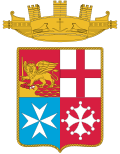 | |
| History | |
|---|---|
| Name | Palinuro |
| Owner | Italian Navy |
| Operator | Italian Navy |
| Builder | Anciens Chantiers Dubigeon, Nantes (France) |
| Laid down | 1933 |
| Launched | 21 March 1934 |
| Commissioned | 1934 |
| Recommissioned | 16 July 1955 |
| Renamed |
|
| Homeport | La Maddalena |
| Identification |
|
| Motto | Faventibus Ventis |
| Status | Still in service |
| General characteristics | |
| Type | Iron-hulled barquentine |
| Tonnage | 858 GT |
| Displacement | 1,341 t (1,320 long tons) full load |
| Length | |
| Beam | 10 m (32 ft 10 in) |
| Height | 37.50 m (123 ft 0 in) at mainmast |
| Draught | 4.80 m (15 ft 9 in) |
| Sail plan | Barquentine rig, 15 sails, 1,000 m2 (11,000 sq ft) |
| Speed | 9.5 knots (17.6 km/h; 10.9 mph) |
| Endurance |
|
| Crew | 84 (of which, 6 officiers) plus 54 cadets/trainees |
| Notes | 2 GEM Elettronica navigation radar: one MM/SPN-754(V)1 and one MM/SPN-754(V)2 as January 2019 [1] |
Palinuro is a three-masted, iron-hulled barquentine, active as sail training vessel for the Italian Navy.
Contents
Palinuro is named after Palinurus the famous helmsman of Aeneas's ship (after the fall of Troy the defeated Trojans detoured the Mediterranean). Palinurus is seen as a prototype of an experienced navigator or guide.



